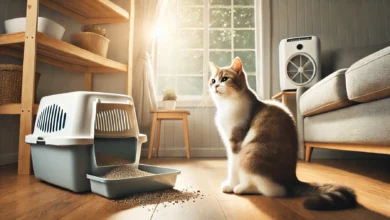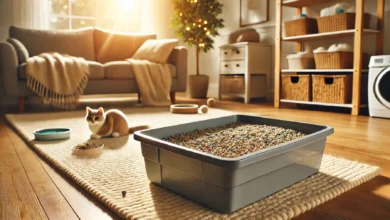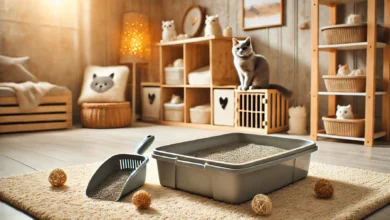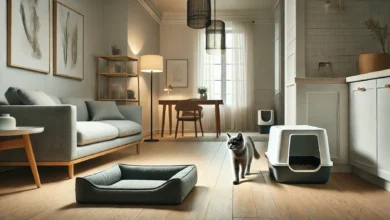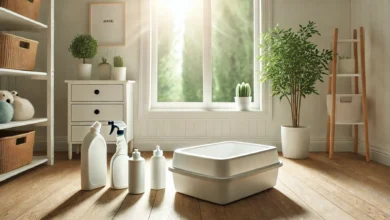Understanding Biodegradable Litter Benefits
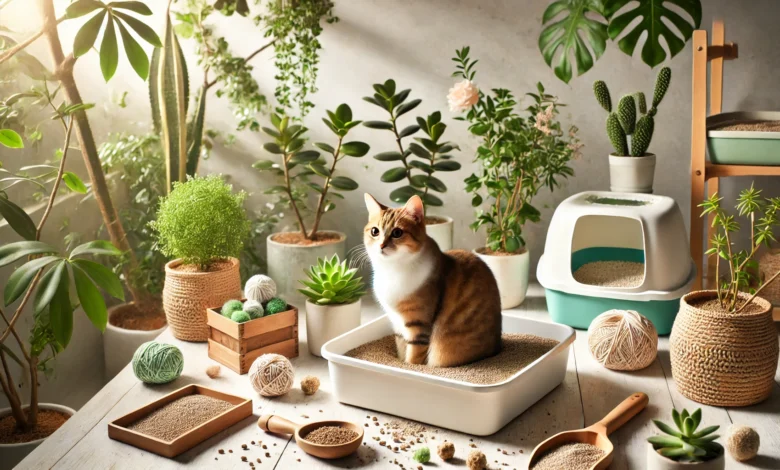
Taking care of your cat entails making decisions that not only have an impact on your pet’s health but also extend to environmental concerns.
One key decision is the type of litter you use.
Biodegradable cat litter has gained recent popularity as an environmentally friendly alternative to the more traditional clay-based litters or silica gel litters.
But what exactly is biodegradable litter, and what makes it better for both your cat and the environment?
In this article, we examine the many advantages of biodegradable litter, from the environmental benefits all the way to the healthy effects that both your cat and your home will appreciate.
Table of Contents
What Is Biodegradable Cat Litter?
Biodegradable cat litter is made from organic, renewable resources that break down easier in nature.
Unlike common litter, which is typically made from mined clay or synthetic materials, biodegradable litter is designed to be eco-friendly.
Common ingredients include plant-based fibers such as wood, corn, wheat, and recycled paper, all of which decompose more quickly and leave less of a footprint on the earth.
The main difference between biodegradable cat litter and traditional litter is that biodegradable litter naturally degrades over time.
This means it doesn’t add to the ever-growing problem of landfill waste caused by millions of tons of cat litter tossed into landfills each year.
Instead, biodegradable options return to the earth without leaving harmful residues behind.
Biodegradable litter is an eco-friendly choice, offering a sustainable alternative to traditional clay-based litter.
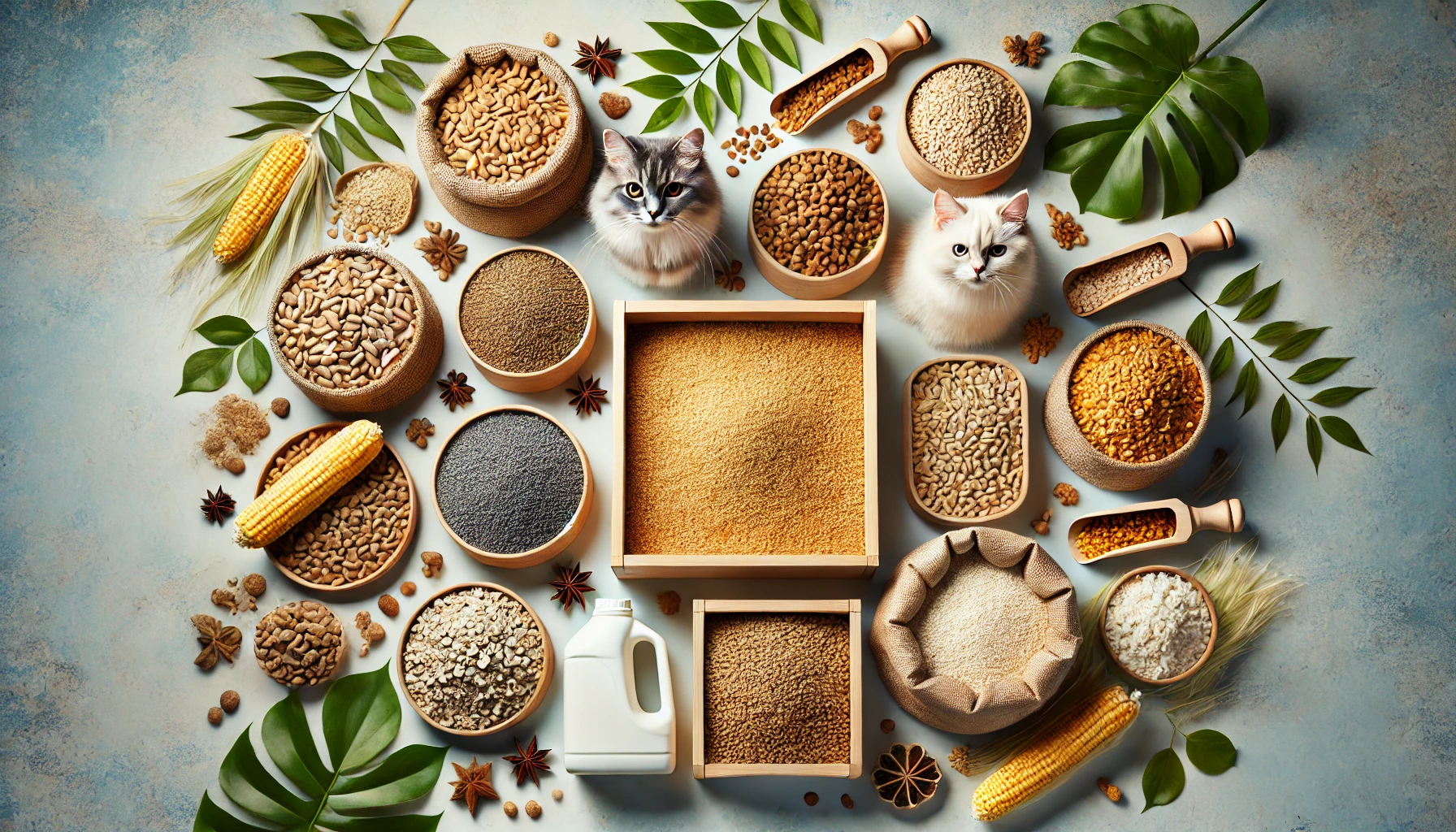
Types of Biodegradable Litter
There are several types of biodegradable litters, each with specific characteristics:
- Wood-based litter: Made from recycled or sawdust wood, this type of litter is highly absorbent and has a natural odor control mechanism.
- Corn-based litter: Comprised of ground corn, this lightweight litter clumps well, making scooping easy.
- Wheat-based litter: Wheat-based litters also clump and contain enzymes for natural odor neutralization.
- Paper-based litter: Made from large quantities of recycled paper, this litter is soft and gentle on your cat’s paws. It is ideal for cats with sensitive skin or paws.
Different types of biodegradable litters have unique characteristics suited to various preferences and needs.

How It Differs from Traditional Cat Litter
The major difference between biodegradable cat litter and traditional cat litter is the environmental impact.
Traditional litters, particularly clay-based ones, are produced through strip mining, a highly detrimental process for the environment.
These litters do not break down, resulting in massive amounts of waste.
In contrast, biodegradable litter comes from renewable resources and breaks down naturally, causing minimal harm to the planet.
Besides being environmentally friendly, biodegradable litter is also lightweight and produces less dust, making it a healthier choice for both you and your cat.
Traditional litters, especially clay-based ones, can raise a lot of dust, which often irritates your cat’s respiratory system and contributes to messes in your home.
Unlike traditional litter, biodegradable options help reduce landfill waste and environmental damage.
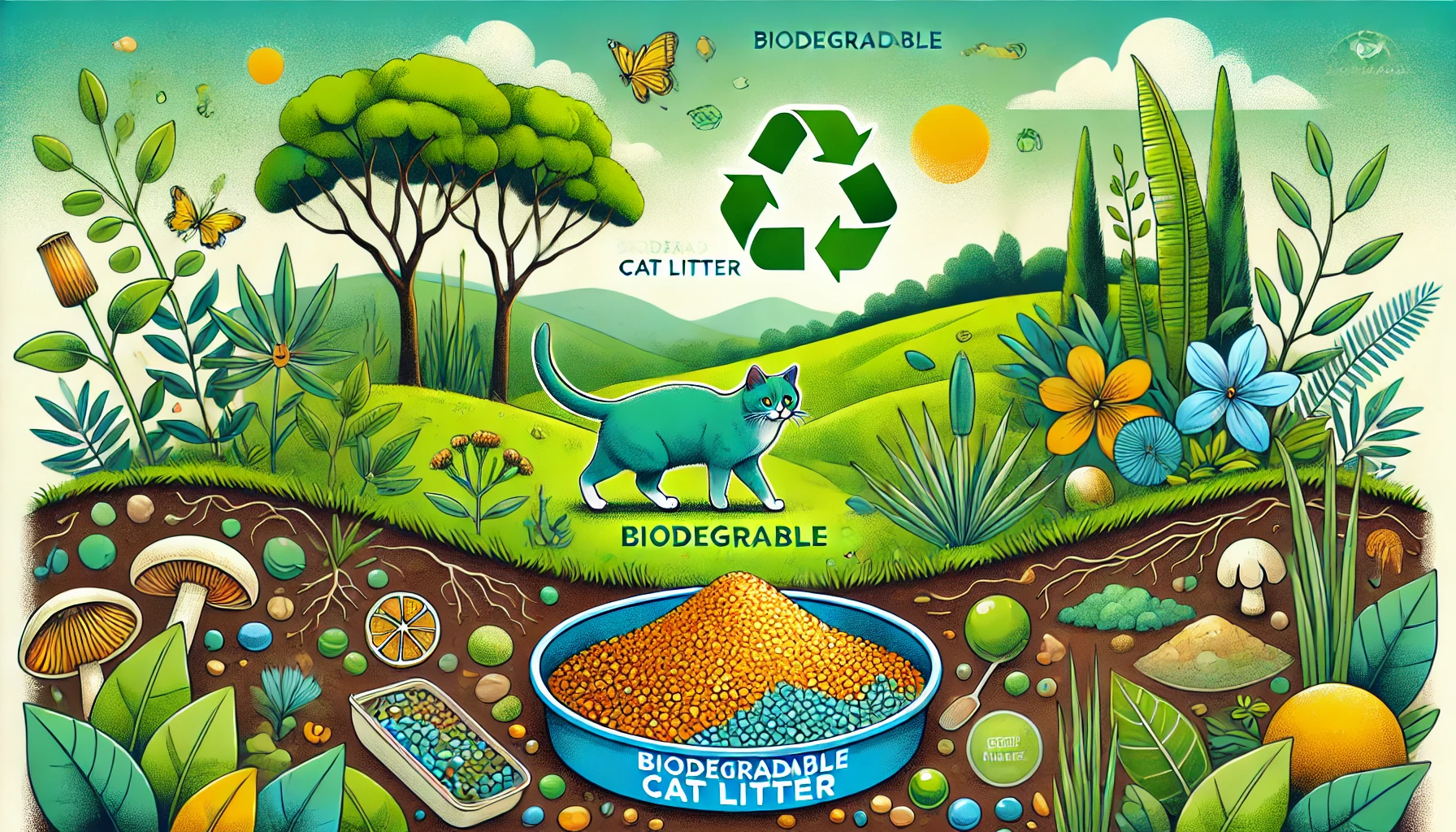
Environmental Benefits of Biodegradable Litter
Equally important, the use of biodegradable litter has a number of environmental benefits.
Most conventional litters, especially clay-based ones, degrade the environment through mining and contribute heavily to landfill waste.
On the other hand, biodegradable cat litter offers an environmentally friendly alternative, which contributes to minimizing waste for sustainable development.
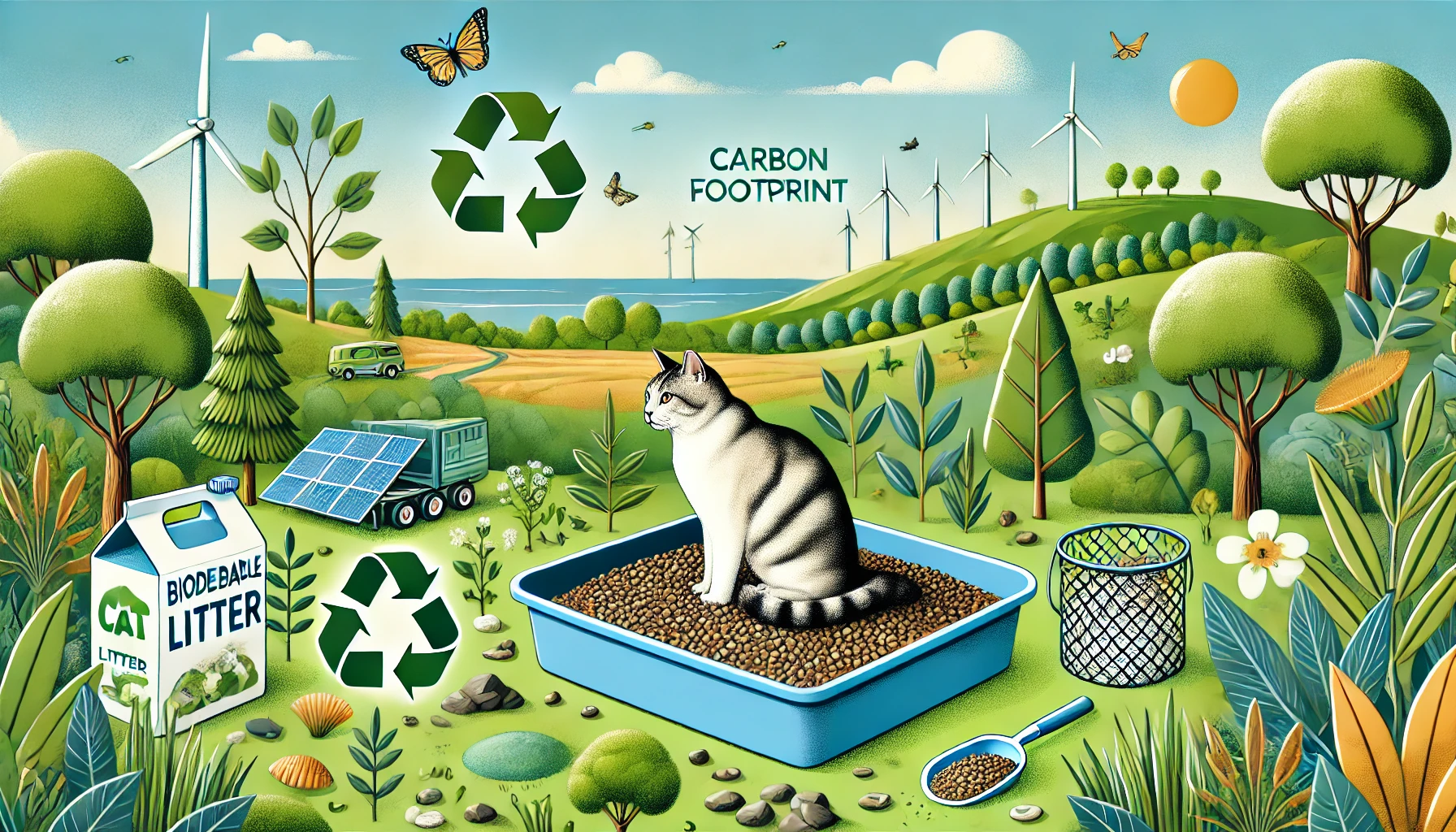
Reducing Carbon Footprint
The manufacturing and disposal of clay-based litters require huge amounts of energy, and the strip mining process is extremely harmful to ecosystems.
By switching to biodegradable litter, carbon footprints are drastically reduced.
Materials such as wood, corn, and wheat used in biodegradable litter are renewable, require fewer resources, and cause much less environmental harm.
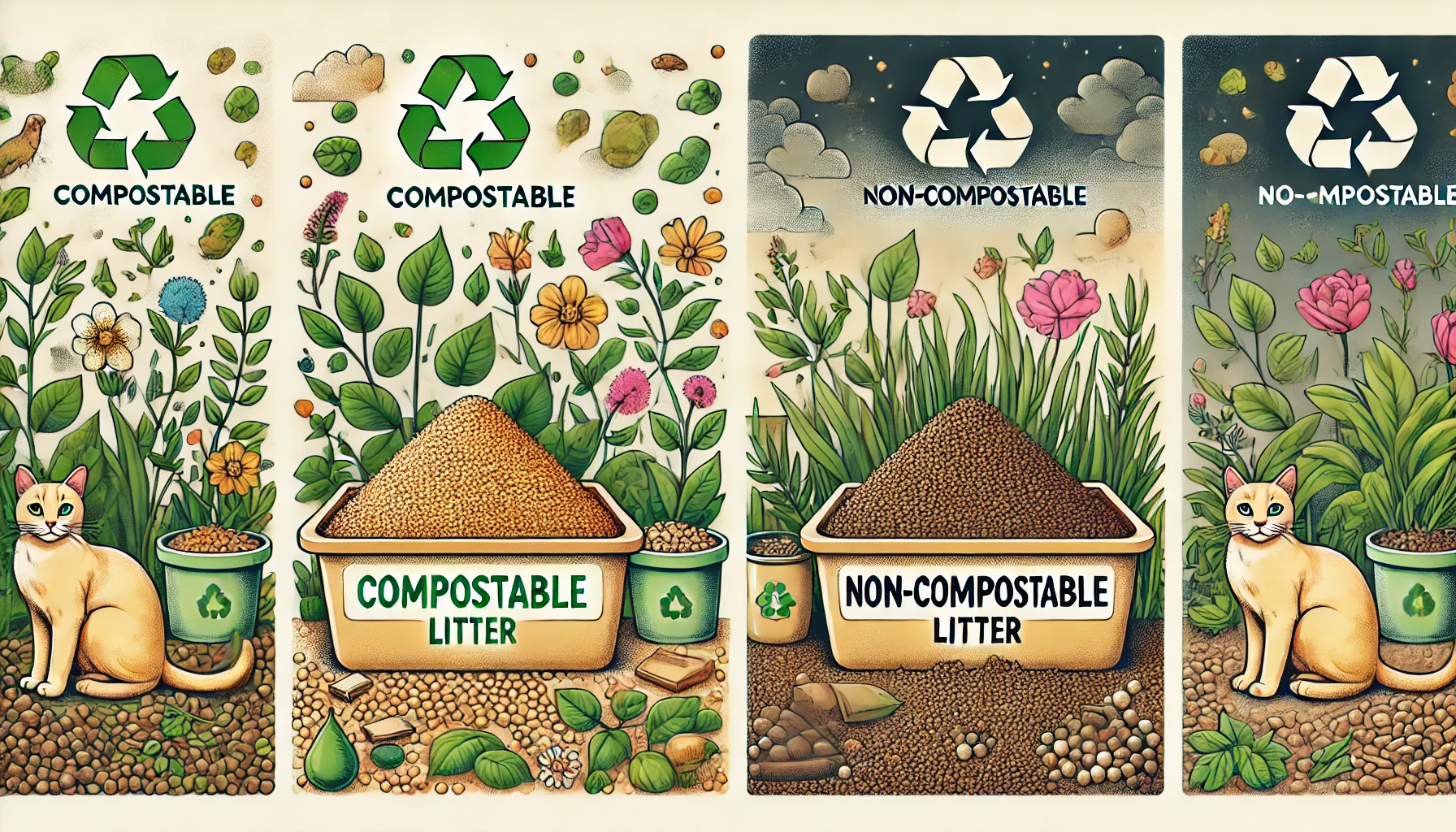
Compostable vs. Non-Compostable Options
Another important ecological benefit of biodegradable litter is that some varieties are compostable.
This means you can safely compost used litter in your garden, recycling nutrients into the soil instead of adding waste to landfills.
However, not all biodegradable litters are compostable—some contain added chemicals or fragrances.
It is always recommended to check the product label to ensure your litter is safe for composting.
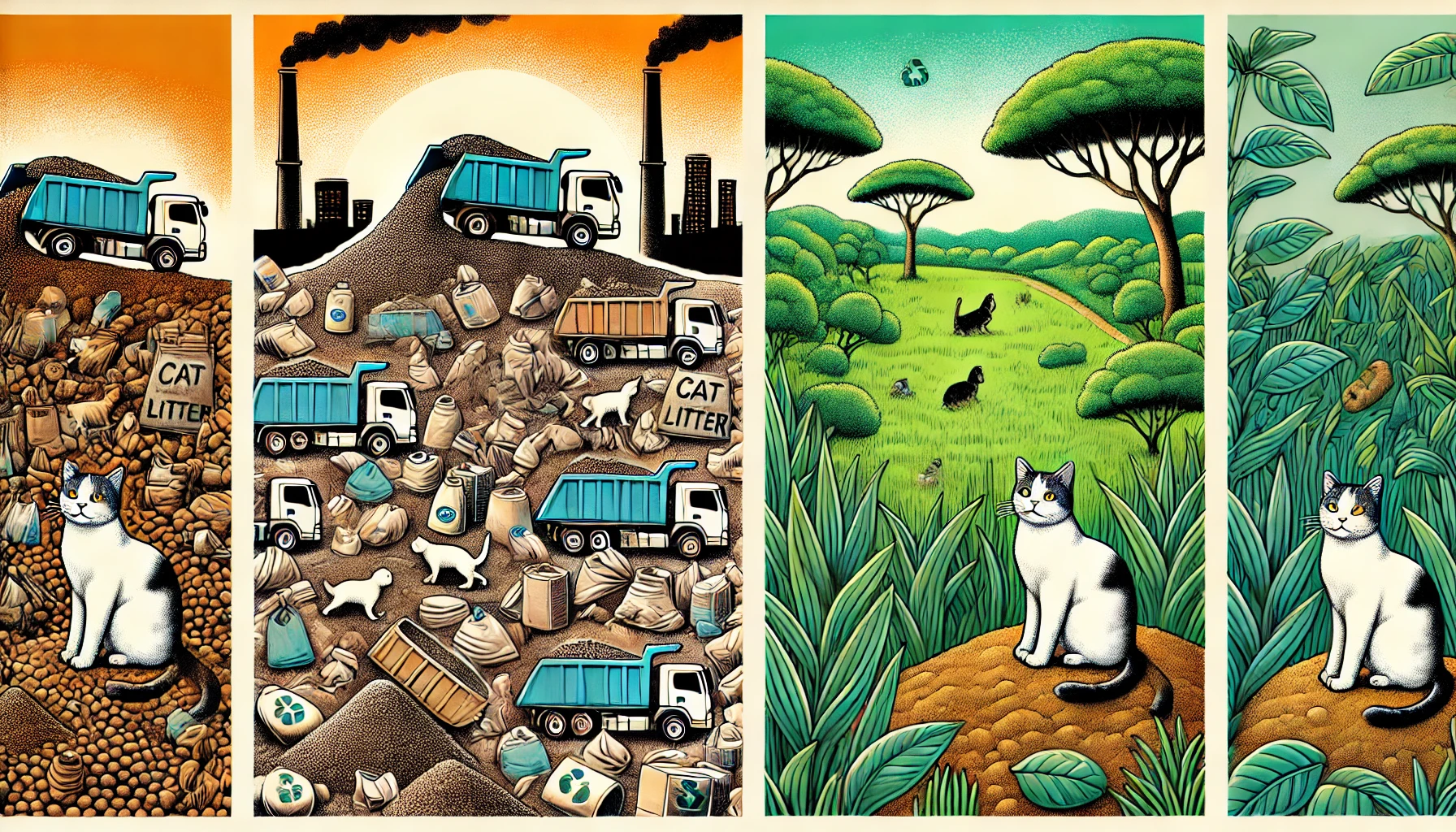
Landfill Impact and Waste Reduction
Standard cat litter, made from clays and silicas, is non-biodegradable and produces millions of pounds of waste in landfills annually.
This contributes to the growing issues of waste management and risks contaminating the soil with harmful chemicals.
Biodegradable cat litter, on the other hand, naturally decomposes, reducing the amount of litter that ends up in landfills by a significant percentage.
Your choice to use biodegradable litter directly contributes to reducing waste that would otherwise take years or even decades to decompose.
In summary, switching to biodegradable litter reduces your carbon footprint, supports renewable resources, and contributes significantly to waste reduction.
Compostable versions offer an even more environmentally friendly approach by allowing you to recycle your cat’s litter into the soil, further minimizing environmental harm.
Choosing biodegradable litter supports sustainability and reduces your carbon footprint.

Health Benefits for Cats and Owners
Besides its environmental benefits, biodegradable cat litter has several health advantages for cats and owners alike.
Traditional cat litters, especially clay-based ones, contain unhealthy chemicals and can release dust that poses health hazards.
The adoption of biodegradable alternatives brings about a much healthier environment for all inhabitants of a house.
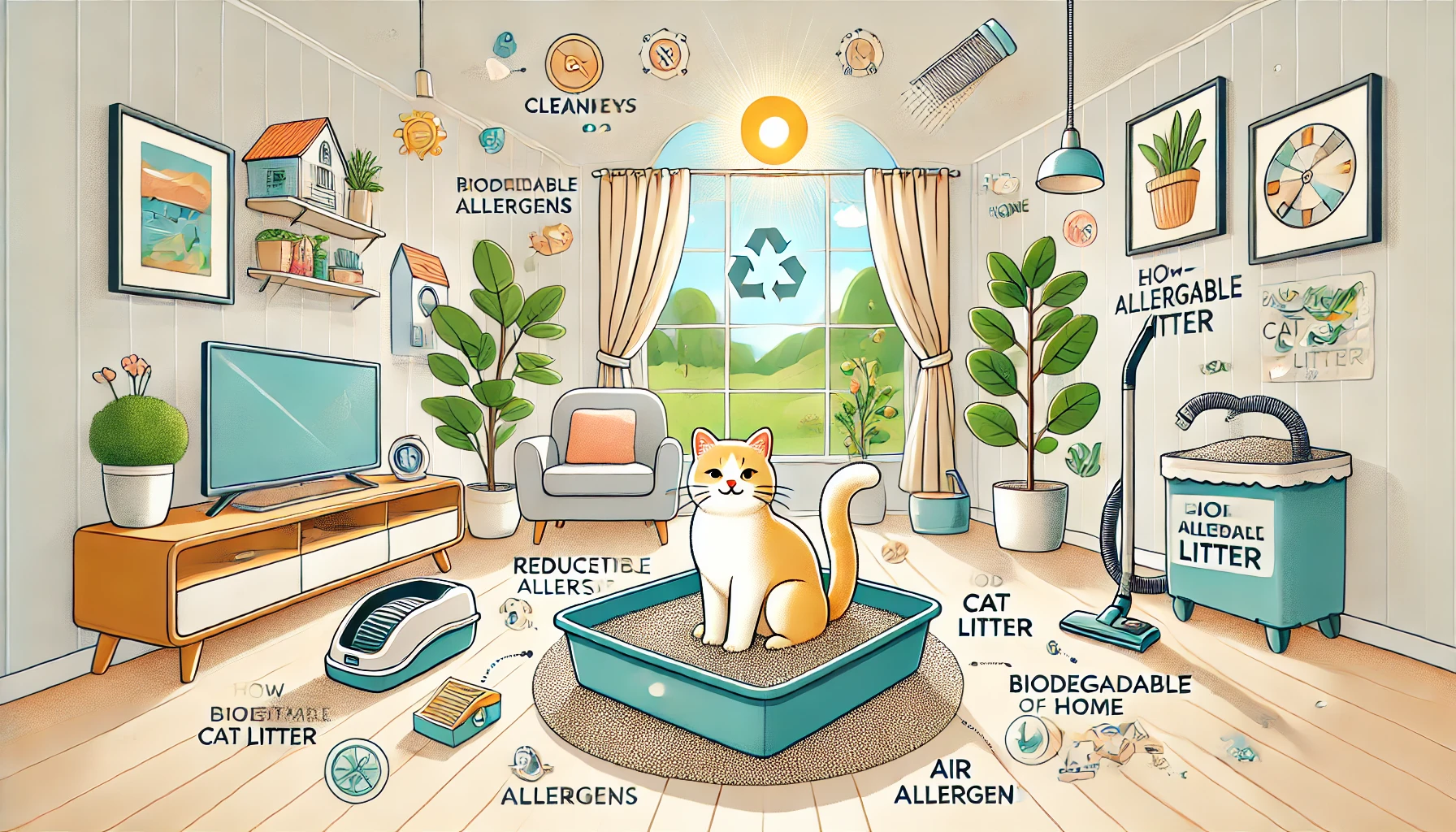
Reducing Home Allergens
Clay-based and silica litters are extremely dusty, regularly releasing large amounts when being poured or used, which can irritate the allergies of both cats and owners.
Particles from these litters may become airborne, mixing with your home’s air and causing respiratory issues.
On the other hand, litter made from biodegradable materials like wood, corn, and recycled paper generates little to no dust, minimizing allergic reactions and keeping the air inside the house cleaner and fresher.
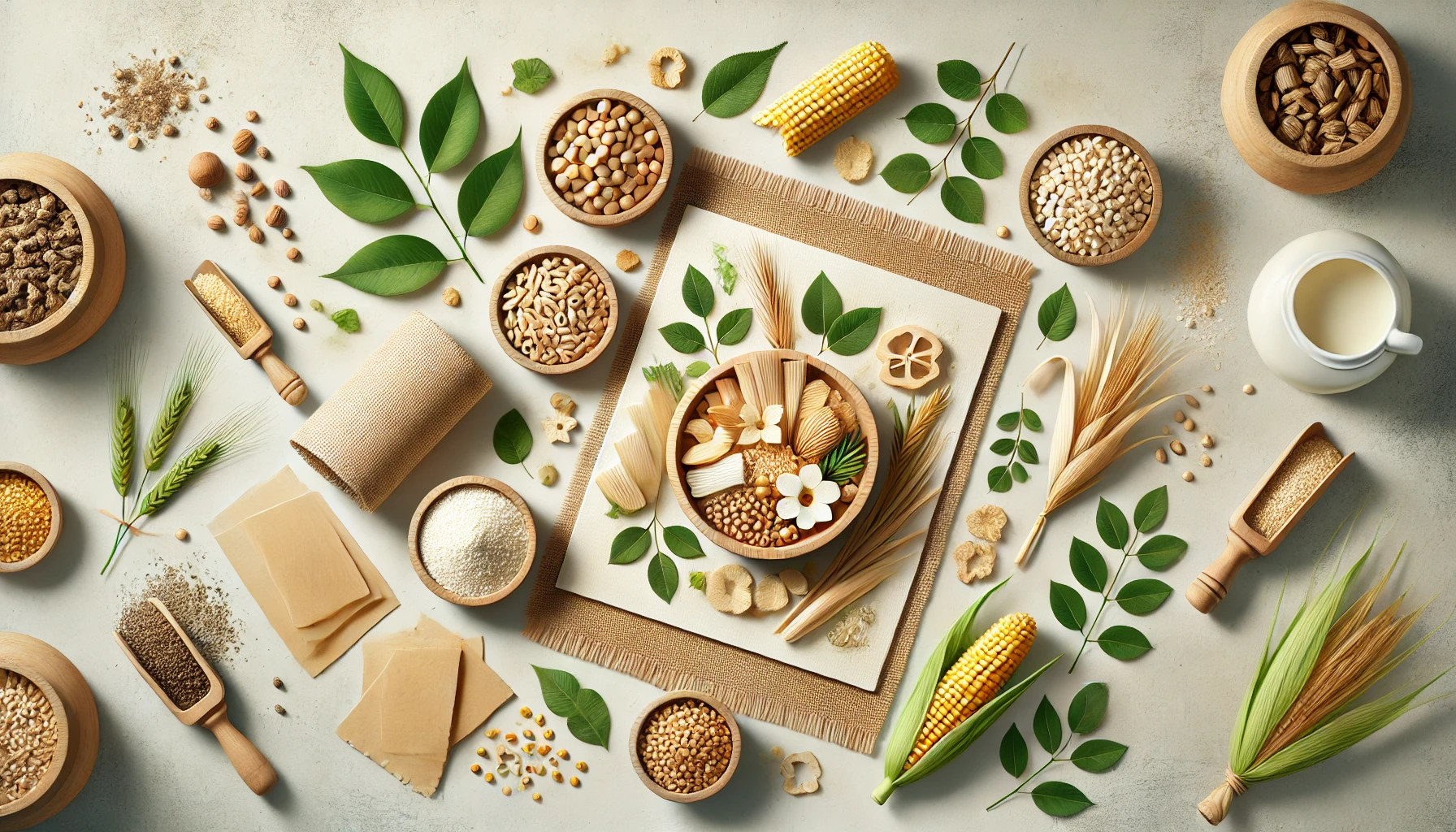
Natural Ingredients and Safer Alternatives
Biodegradable cat litter is manufactured from renewable, plant-based materials that are free from synthetic chemicals and additives.
This makes it safer for cats with sensitive skin or respiratory problems.
Traditional litters might contain fragrances, deodorizers, and clumping agents, which could irritate your cat’s skin or respiratory system.
Using biodegradable litter helps avoid these risks, providing a much safer and more comfortable litter box experience for your cat.
- Wood-based litters: Known for their ability to neutralize odors without the need for added chemicals.
- Paper-based litters: Soft and gentle on cats’ paws, especially beneficial for cats with sensitive skin.
- Corn or wheat-based litters: Naturally clumping without the use of synthetic clumping agents.
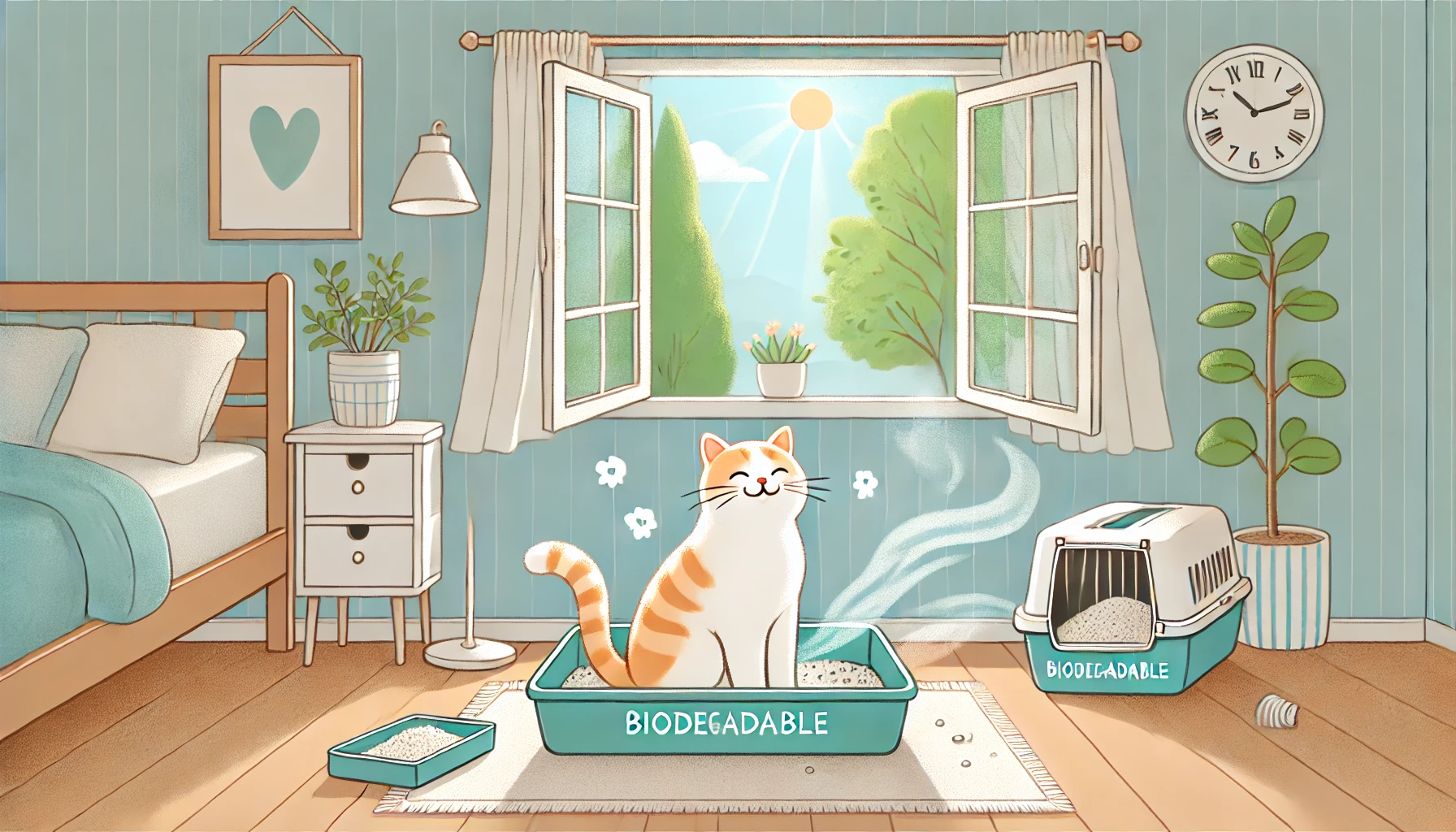
Reducing Respiratory Issues for Cats
Traditional cat litters, especially clay-based ones, can create fine dust particles that irritate a cat’s respiratory system.
Cats suffering from asthma or other respiratory sensitivities are particularly vulnerable to these particles.
Biodegradable cat litter is usually dust-free or low in dust, helping to prevent respiratory issues and making it a much better option for cats prone to breathing difficulties.
All in all, using biodegradable litter ensures a cleaner environment and a healthier home for both you and your cat.
With natural ingredients, you reduce allergens, avoid respiratory problems, and offer a safer alternative to the synthetic chemicals found in traditional litters.
Biodegradable litter is a healthier choice, reducing allergens and respiratory issues for both cats and owners.
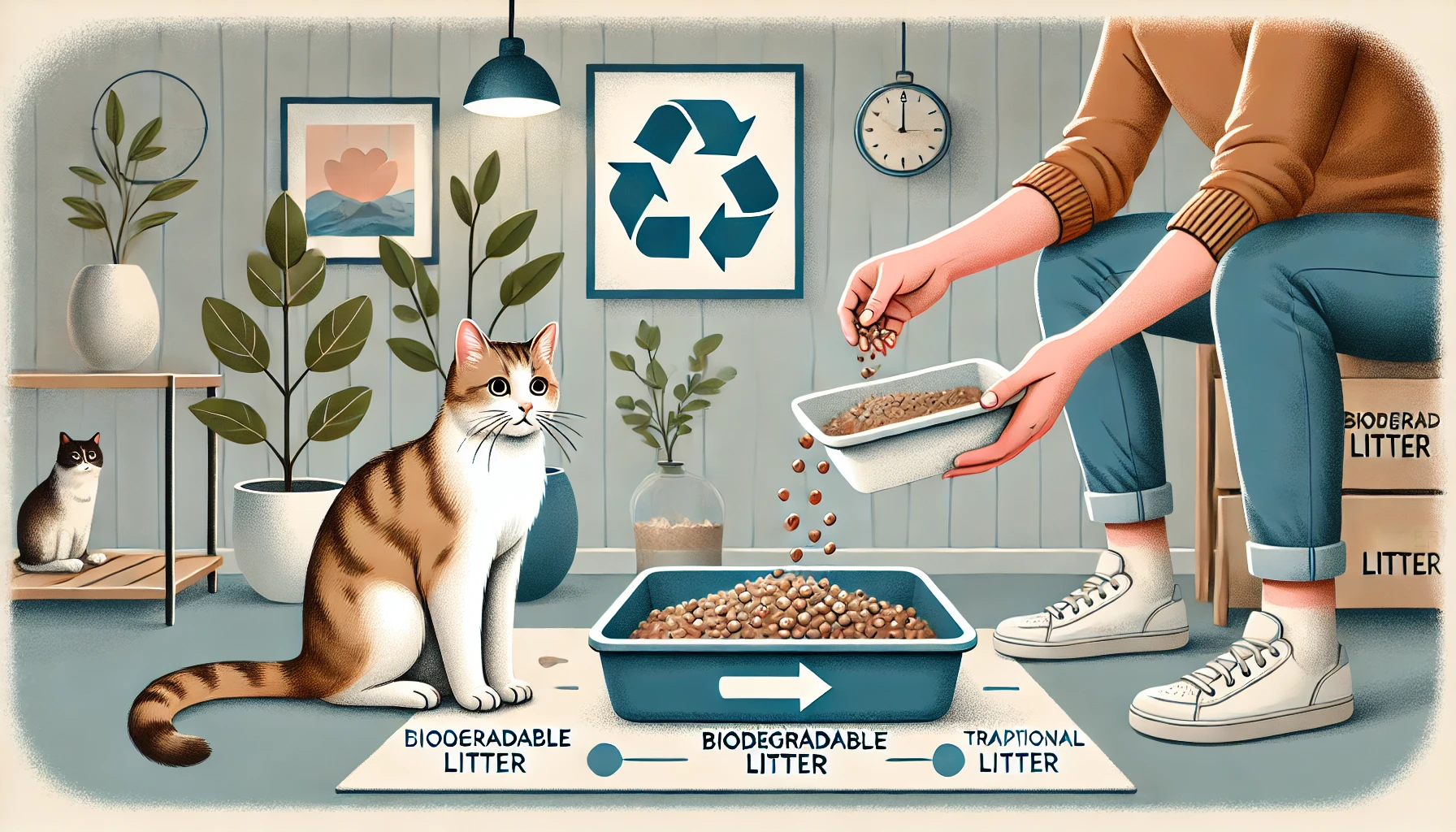
How to Switch Your Cat to Biodegradable Litter
These days, making the switch to biodegradable cat litter is a smart and environmentally conscious decision.
However, for your cat, it may be challenging to get accustomed to a new type of litter.
Cats are creatures of habit and often dislike any type of change—even small ones in their litter box.
But, with the right approach, this transition can be stress-free for both of you.
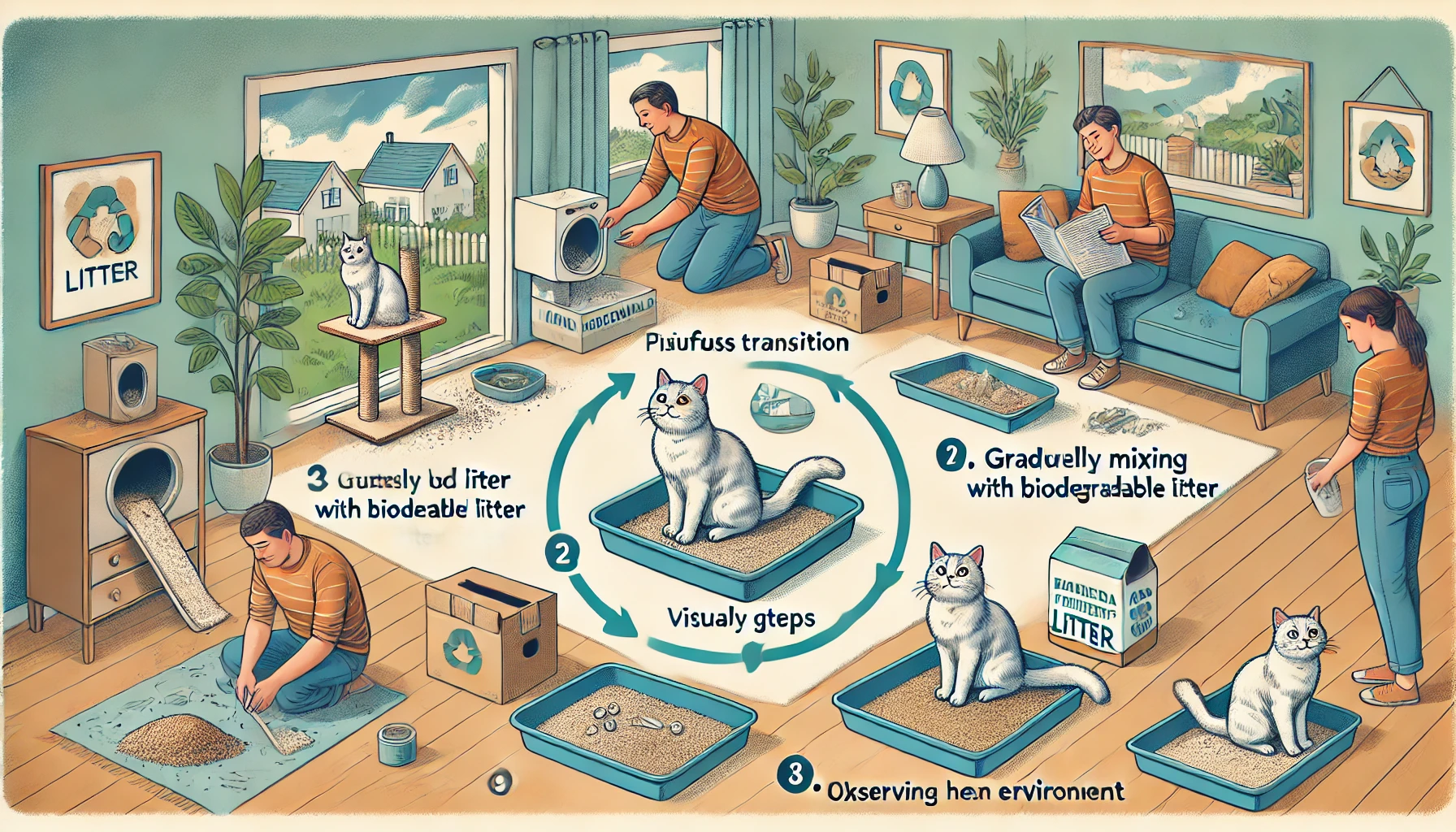
Painless Transition: A Step-by-Step Guide
Introduce biodegradable litter gradually for a smooth adaptation.
Here is a step-by-step guide to help with the process:
- Step 1: Mix small amounts of biodegradable litter with your cat’s current litter to help them get used to the new texture and smell.
- Step 2: Over 7 to 10 days, gradually increase the amount of biodegradable litter while decreasing the amount of the old litter.
- Step 3: Monitor your cat’s behavior during the process. If they seem hesitant, slow down the transition to avoid stressing them.
- Step 4: Once they seem comfortable, fully switch to biodegradable litter. Be sure to clean the litter box frequently to keep the environment fresh.
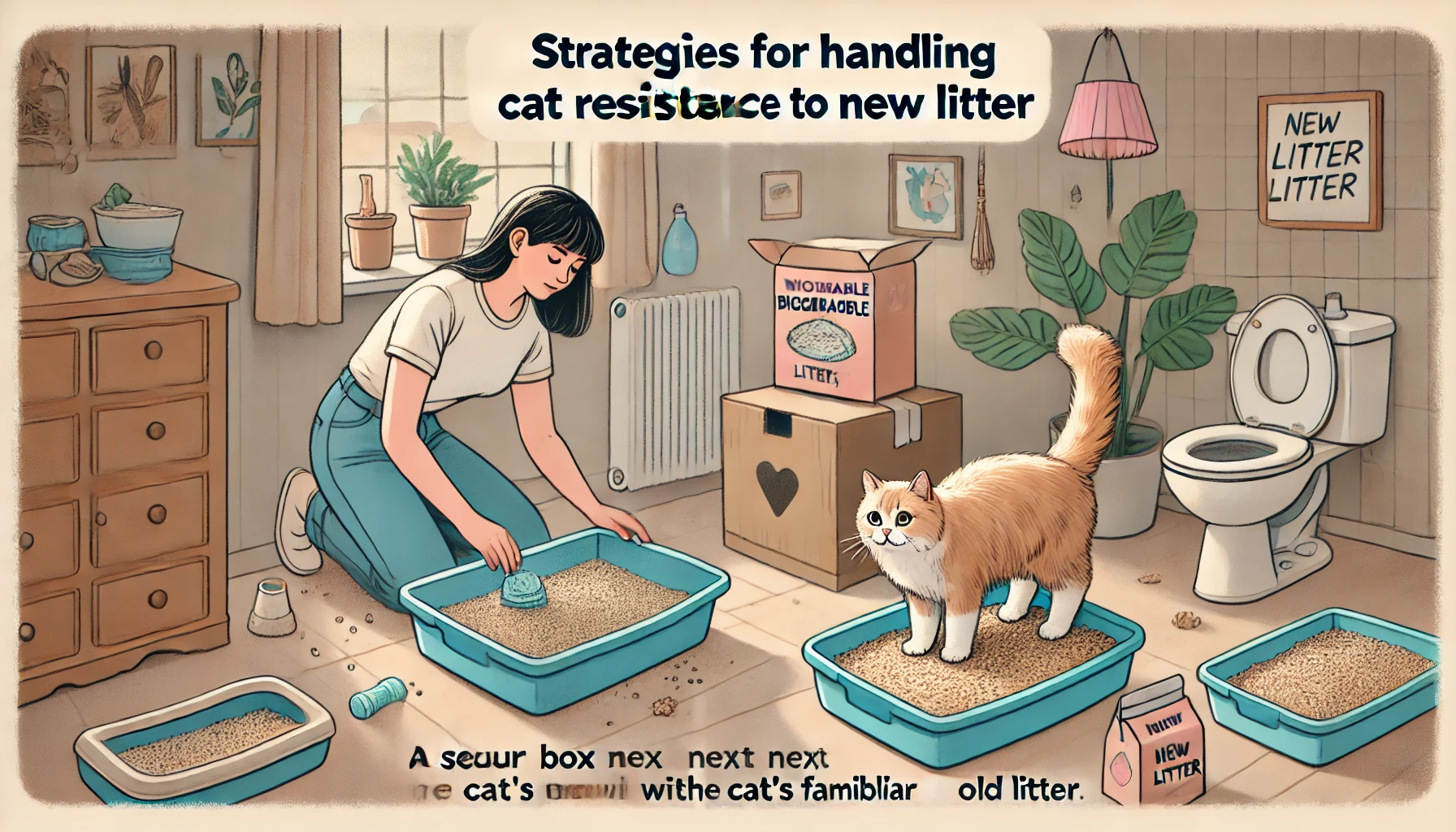
Handling Cat Resistance to New Litter
It’s normal for some cats to resist new litter when it’s introduced.
They might refuse to use the litter box or go outside of it.
If this happens, consider the following tips:
- Place a second litter box next to the new one, but fill it with the old litter your cat is used to. This gives them a choice, and often they will start using the biodegradable litter naturally.
- Ensure the new litter doesn’t have strong scents or perfumes that might deter your cat.
- If resistance continues, try mixing in smaller amounts of biodegradable litter and lengthen the transition period.
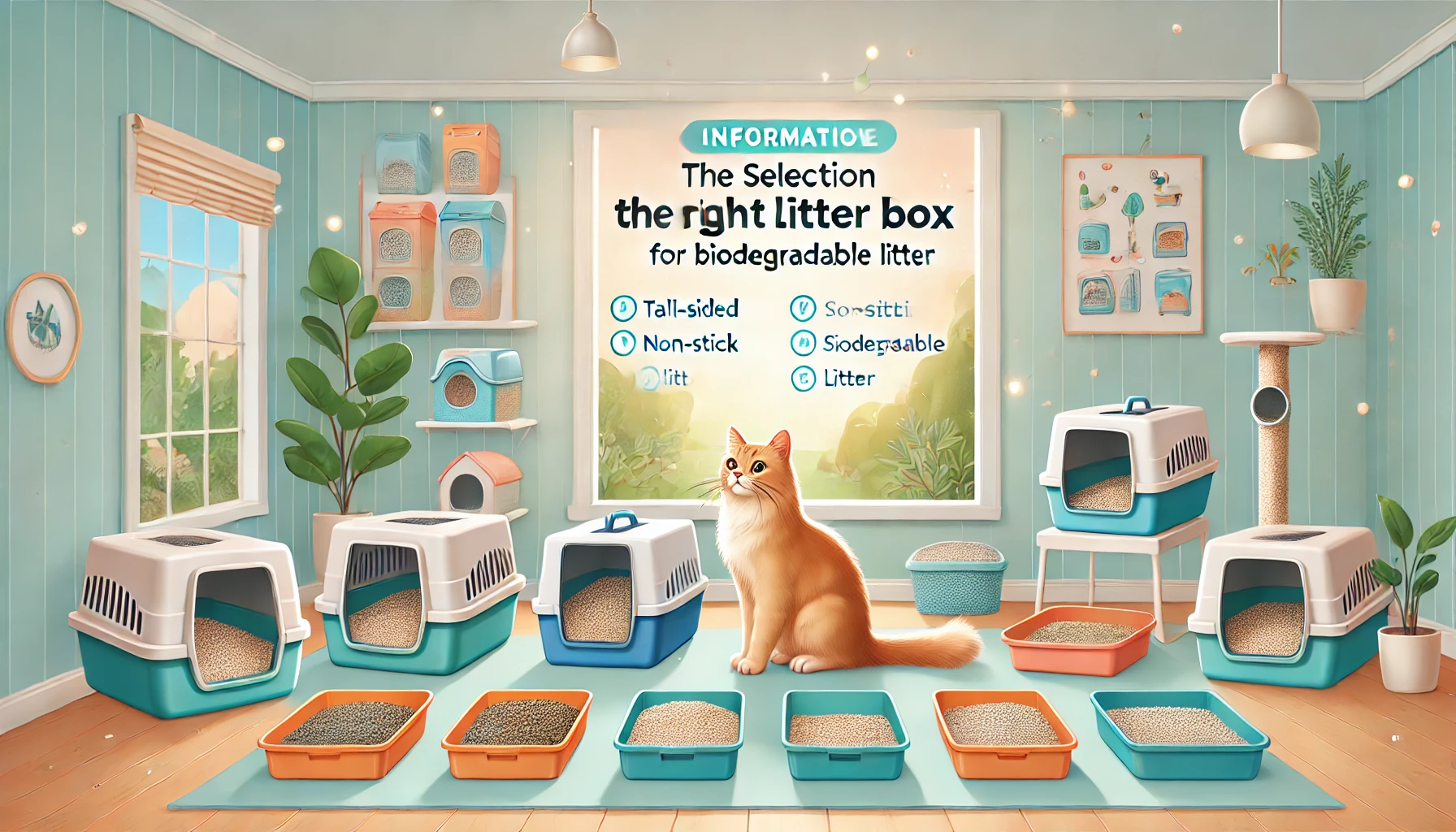
Selecting the Right Litter Box for Biodegradable Litter
Switching to biodegradable cat litter also means you need to choose an appropriate litter box.
Biodegradable litters, particularly clumping varieties, require a litter box that makes cleaning easier.
Look for a box with the following features:
- Tall sides: Biodegradable litter is often lighter, so cats might scatter it more. A box with higher sides helps keep the litter contained.
- Non-stick surface: Clumping biodegradable litter can stick to the sides of the box. A non-stick or coated surface makes it easier to clean.
- Sifting mechanism: Some biodegradable litters work well with sifting litter boxes, making it easier to separate waste from clean litter.
With time and patience, transitioning to biodegradable litter can be easier than you think.
By gradually introducing the new litter and ensuring your cat is comfortable, you’ll not only make your cat happy but also help the environment.
It’s a win for both your kitty and the planet.
Transitioning to biodegradable litter can be easy with the right approach, helping your cat adapt stress-free.
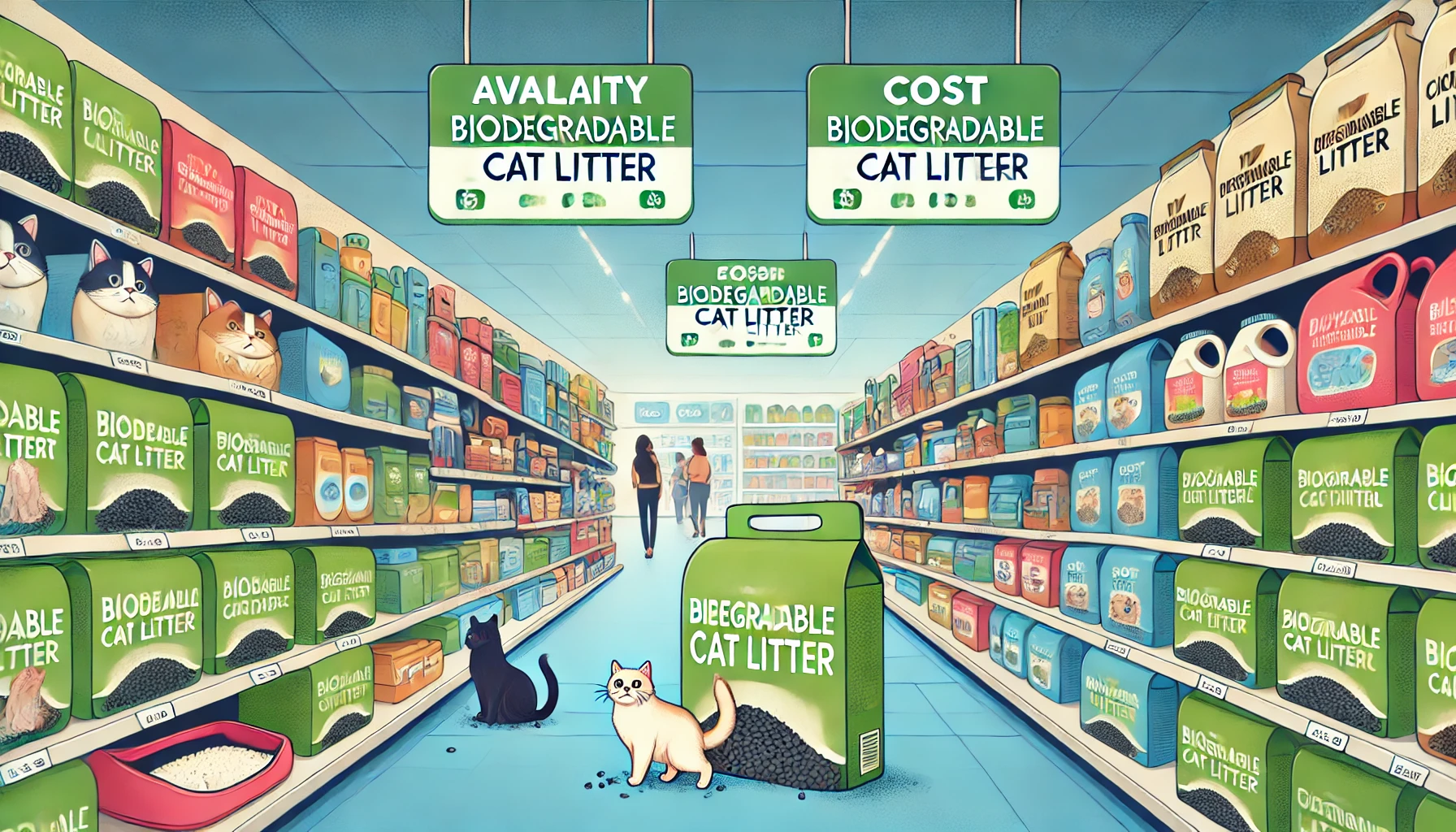
Availability and Cost of Biodegradable Cat Litter
The reason many people stay away from biodegradable cat litter is the preconceived notion that it costs more and is harder to find.
However, with the growing demand for eco-friendly products, biodegradable litter has become more accessible for purchase.
These days, many pet owners are weighing the cost against the health and environmental benefits.
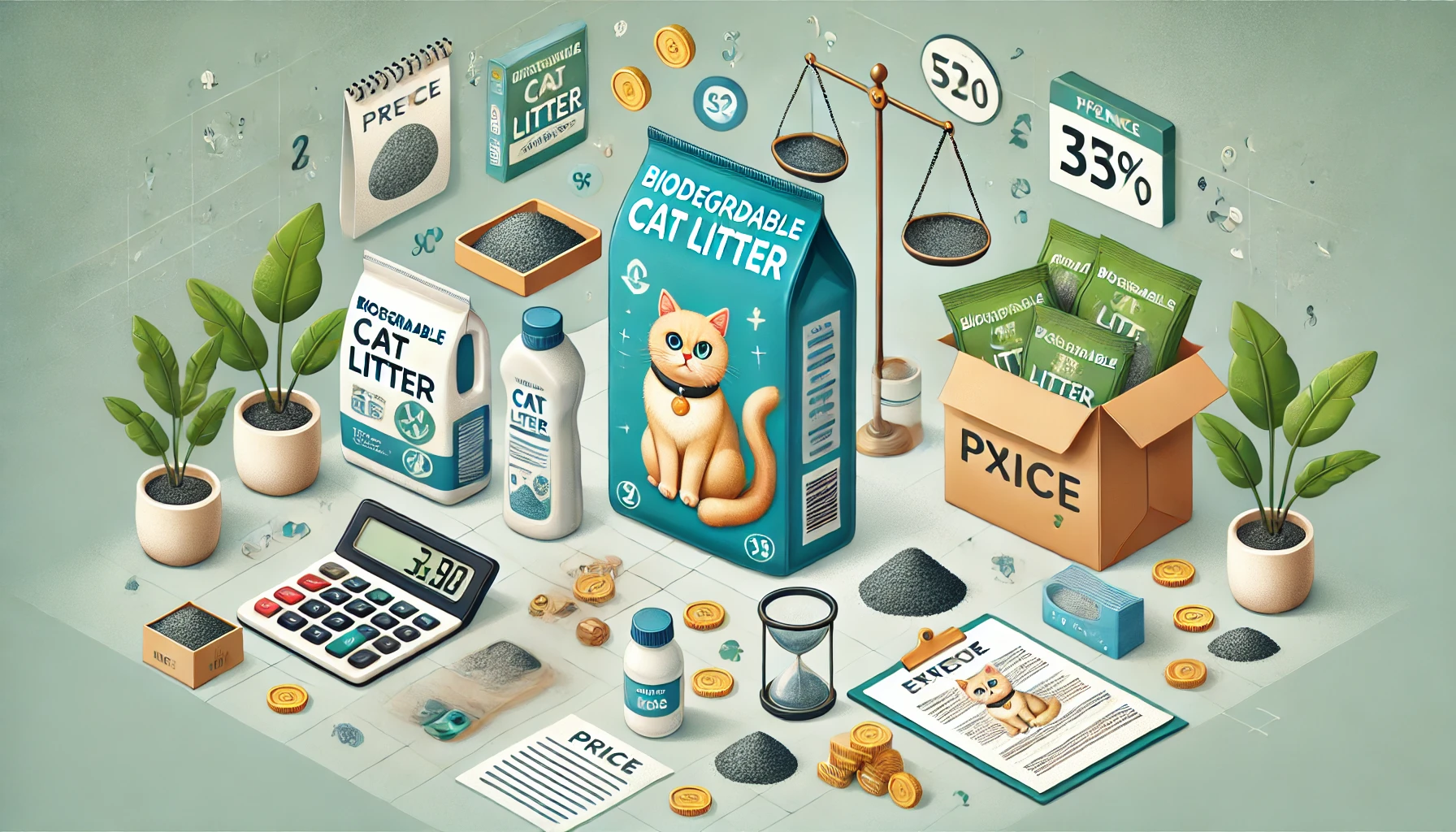
Is Biodegradable Litter Expensive?
While it’s true that some biodegradable litters can be a bit more expensive than traditional clay-based ones, the price difference is generally small.
The exact cost depends on the brand and the type of material used.
Paper-based litters typically fall into the lower price range, while premium wood or corn-based litters tend to be priced higher.
When you factor in the long-term benefits, the added cost of biodegradable cat litter becomes easier to justify.
Many biodegradable litters are more absorbent, meaning you could use less over time.
Additionally, the health benefits for your cat and the reduced environmental impact add value beyond just the price.
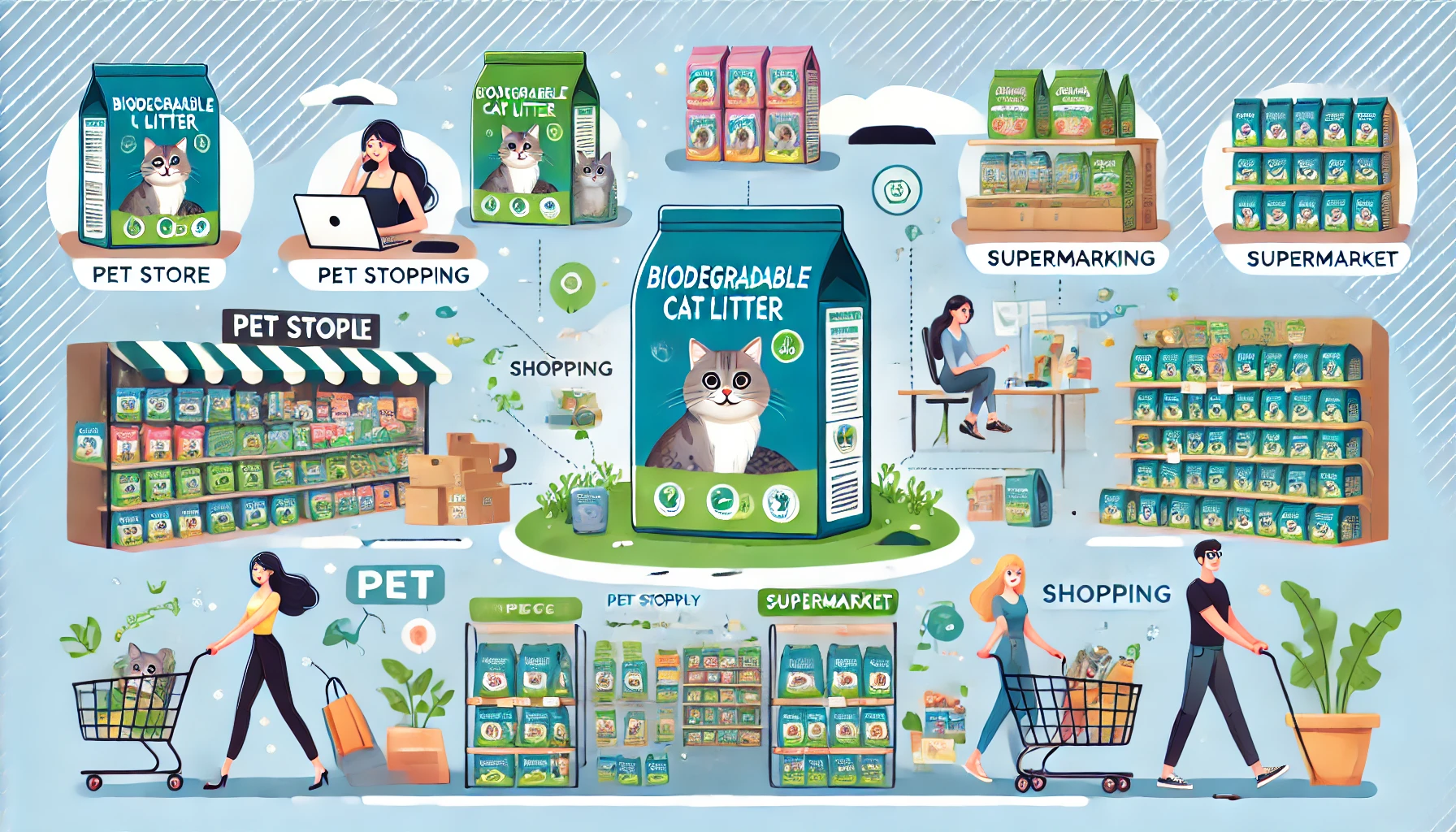
Where to Buy Biodegradable Litter
Biodegradable cat litter is becoming increasingly available, with several eco-friendly brands now sold at pet stores, supermarkets, and online retailers.
Here are some places to buy biodegradable litter:
- Pet Stores: Many large pet store chains stock multiple brands of biodegradable litter, offering everything from wood-based to paper and corn-based varieties.
- Supermarkets: Some supermarkets, particularly those that focus on sustainable products, have started to stock biodegradable litter in their pet care sections.
- Online Retailers: Websites like Amazon, Chewy, and other pet supply stores offer a wide selection of biodegradable litters, often with discounts for bulk purchases or subscriptions.
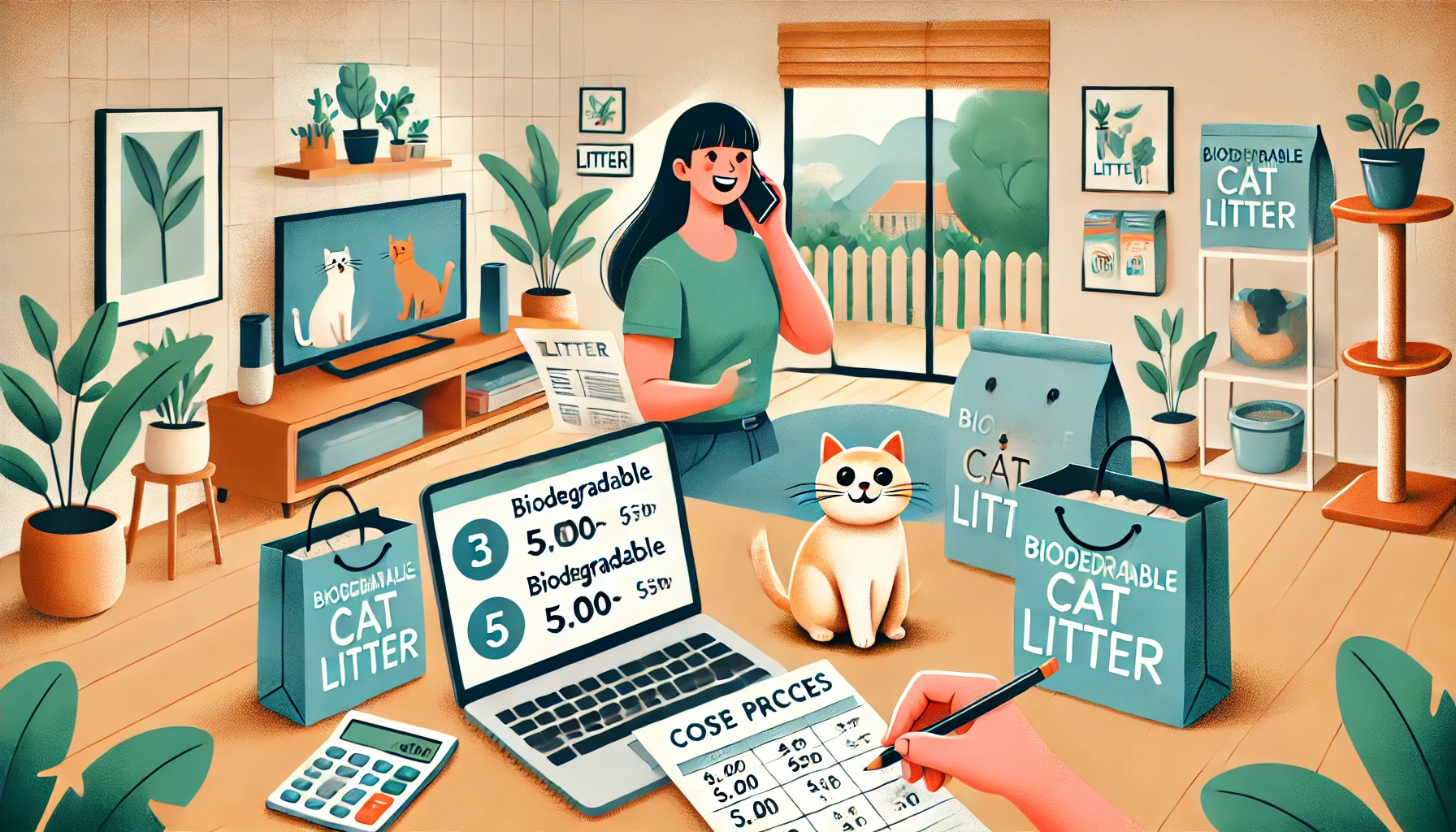
How to Make the Switch Affordable
If you’re concerned about the cost, here are some tips to make the switch to biodegradable litter more economical:
- Bulk Up: Many brands offer discounts when you buy larger quantities, reducing the overall cost per pound of litter.
- Look for Sales and Promotions: Keep an eye out for sales at pet stores or online, particularly during seasonal promotions.
- Use Less Litter: Since many biodegradable litters are more absorbent, you can often use less per litter box fill, making the litter last longer.
In the end, while biodegradable litter may be slightly more expensive, it is becoming increasingly affordable and accessible.
With its health and environmental benefits, many pet owners find that the switch to biodegradable litter is a worthwhile investment in the long run.
Biodegradable litter is increasingly available and, while slightly more expensive, offers long-term value.
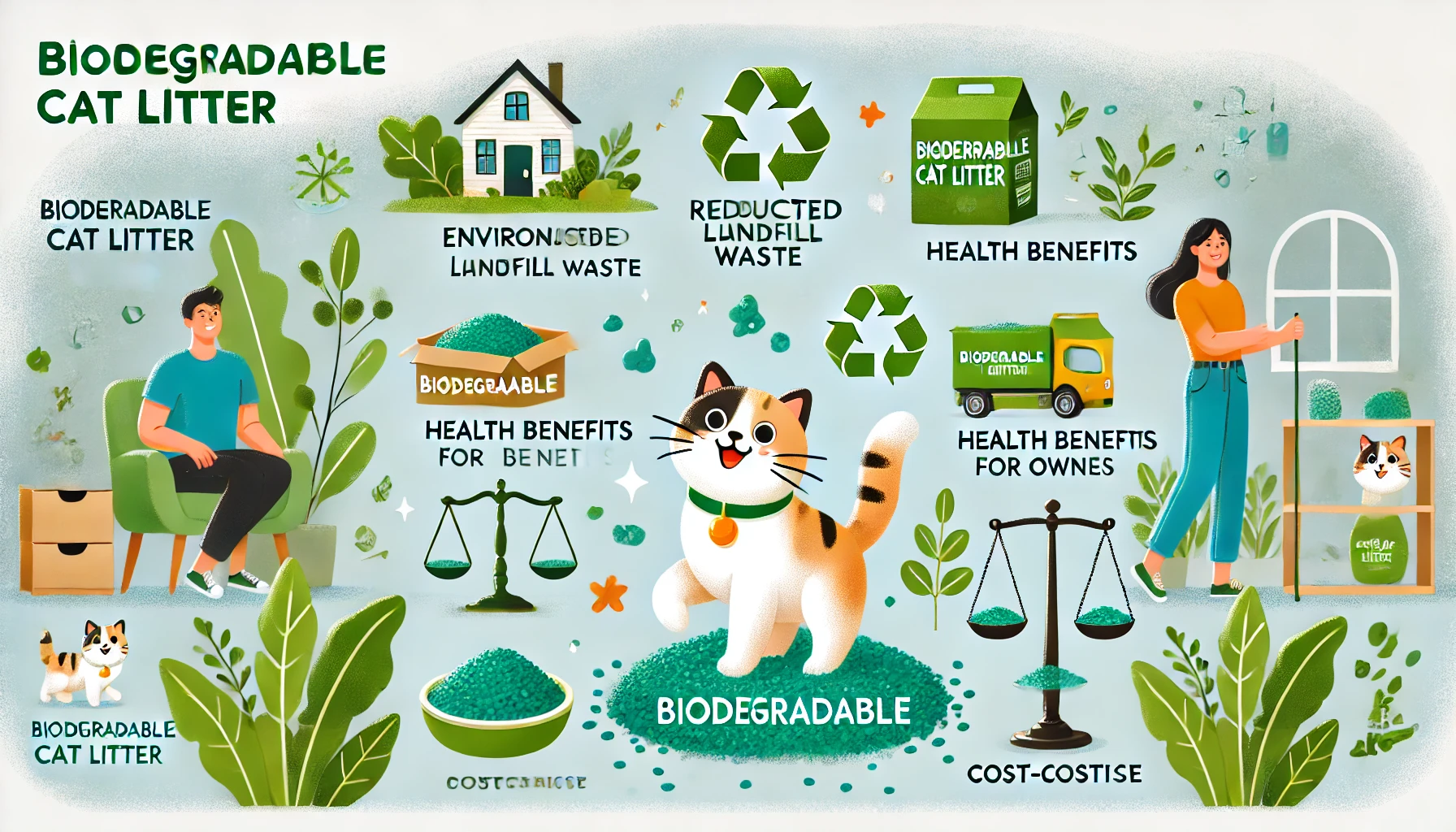
The Benefits of Biodegradable Cat Litter: An All-Inclusive Summary
Your switch to biodegradable cat litter comes with numerous significant advantages, benefiting both your cat and the environment.
Throughout this article, we have explored the environmental, health, and practical reasons for making such a switch, providing clear guidance on how to choose a more sustainable option for your pet.
From its eco-friendly production to its health benefits, biodegradable litter has much to offer.
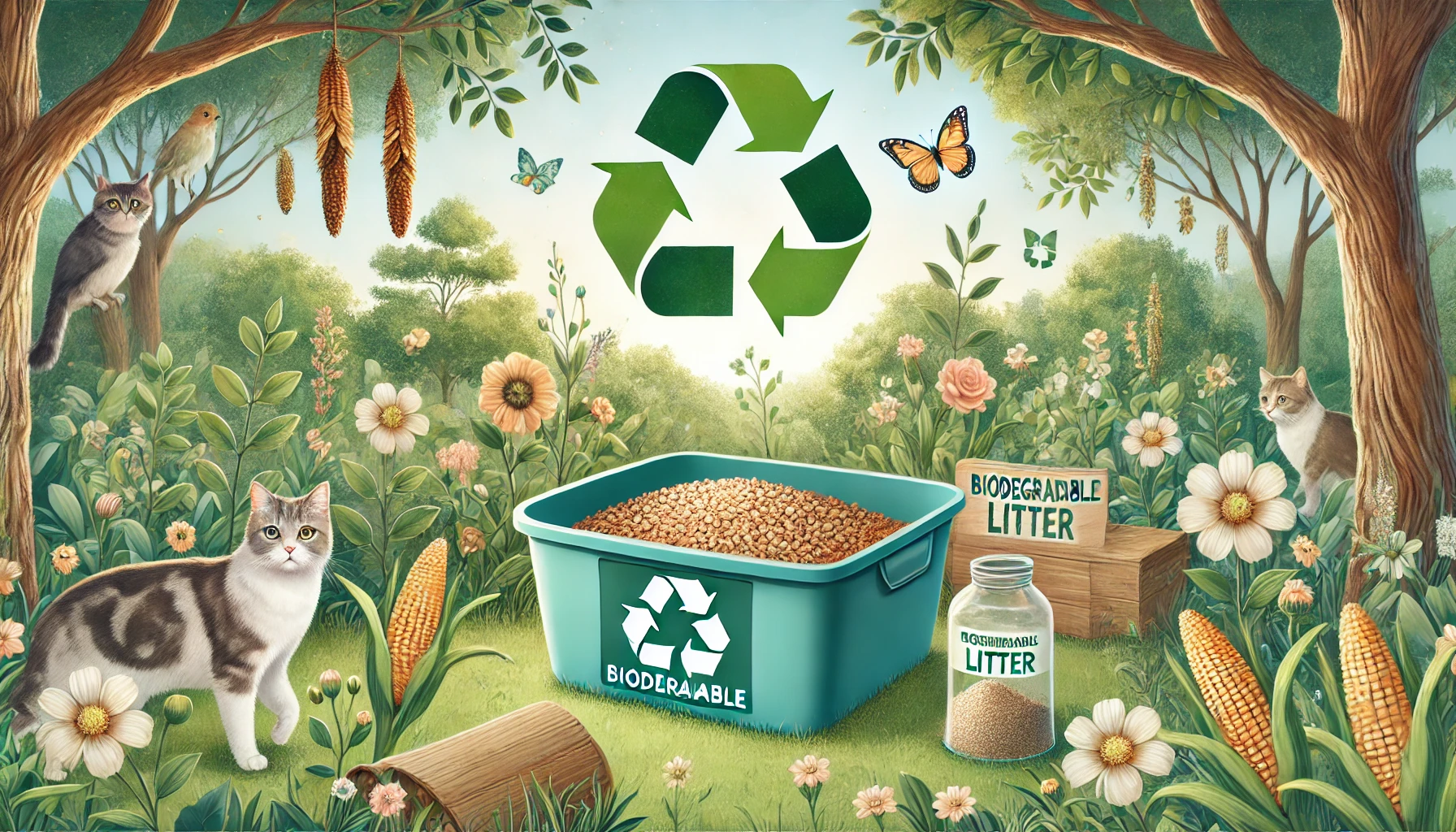
Environmentally Friendly and Sustainable Choice
One of the most critical reasons to adopt biodegradable cat litter is its role as an ecological substitute.
Unlike traditional clay-based litters, biodegradable litter does not harm the environment.
It is made from renewable raw materials like wood, corn, wheat, and even paper, which easily decompose in nature, reducing waste and landfill contributions.
This sustainable solution meets the growing demand for eco-friendly products, making it a responsible choice for pet owners who care about the environment.
In addition, most biodegradable litters are compostable, offering an even greater opportunity for waste reduction.
By composting used litter, pet owners actively participate in environmental conservation by recycling nutrients back into the soil rather than adding to landfills.
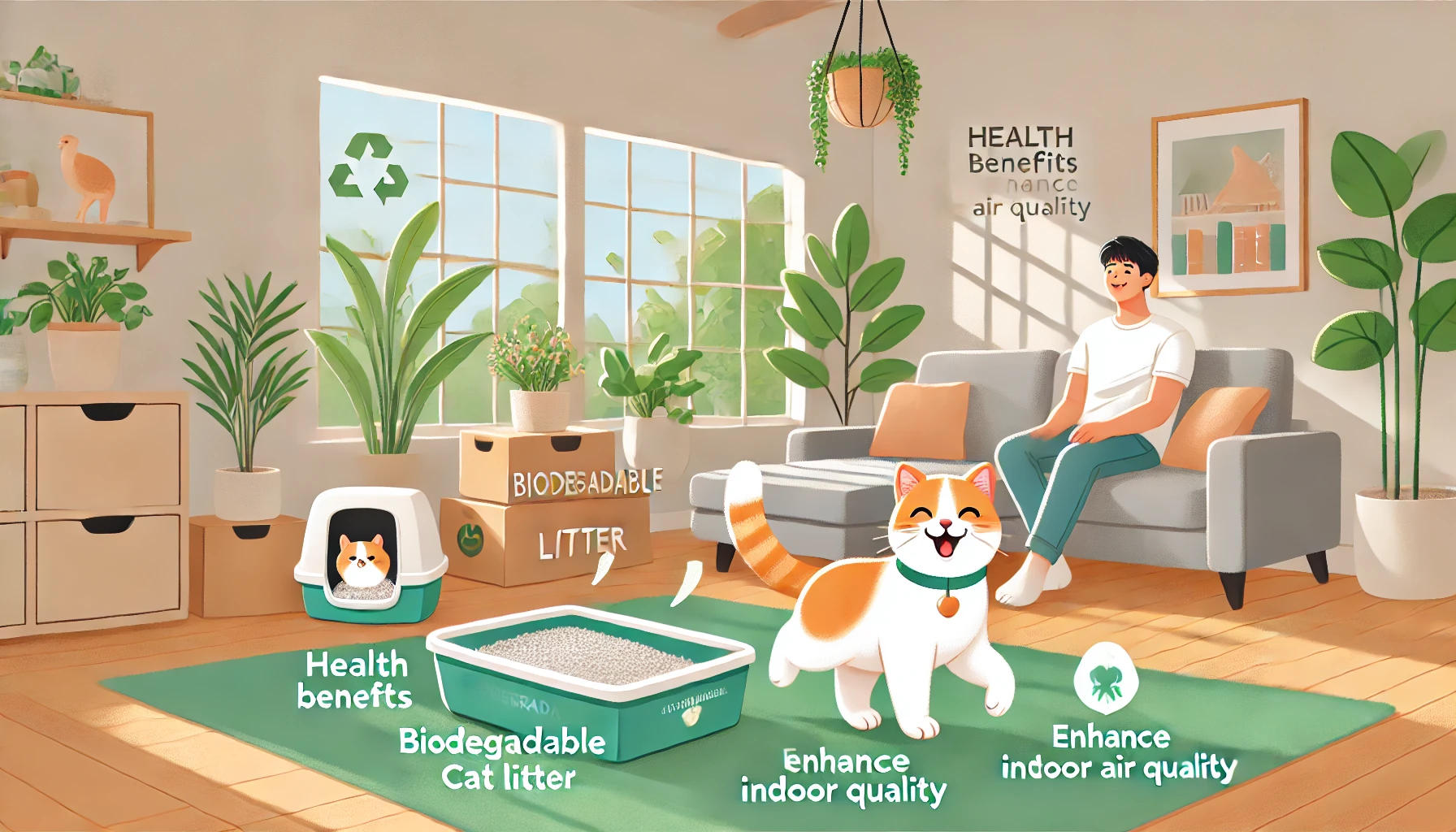
Health Benefits for Your Cat and Home
Biodegradable cat litter offers substantial health benefits.
Traditional litters, particularly those made from clay or silica, can release harmful dust and chemicals, which may cause respiratory issues in both cats and their owners.
Biodegradable alternatives, however, are typically dust-free or low in dust, making them a safer choice for sensitive cats and households prone to allergic reactions.
These litters are made from natural, plant-based materials and are free from artificial additives, fragrances, or clumping agents that could irritate your cat’s skin or respiratory system.
This results in a cleaner, healthier living space for both your cat and your home.
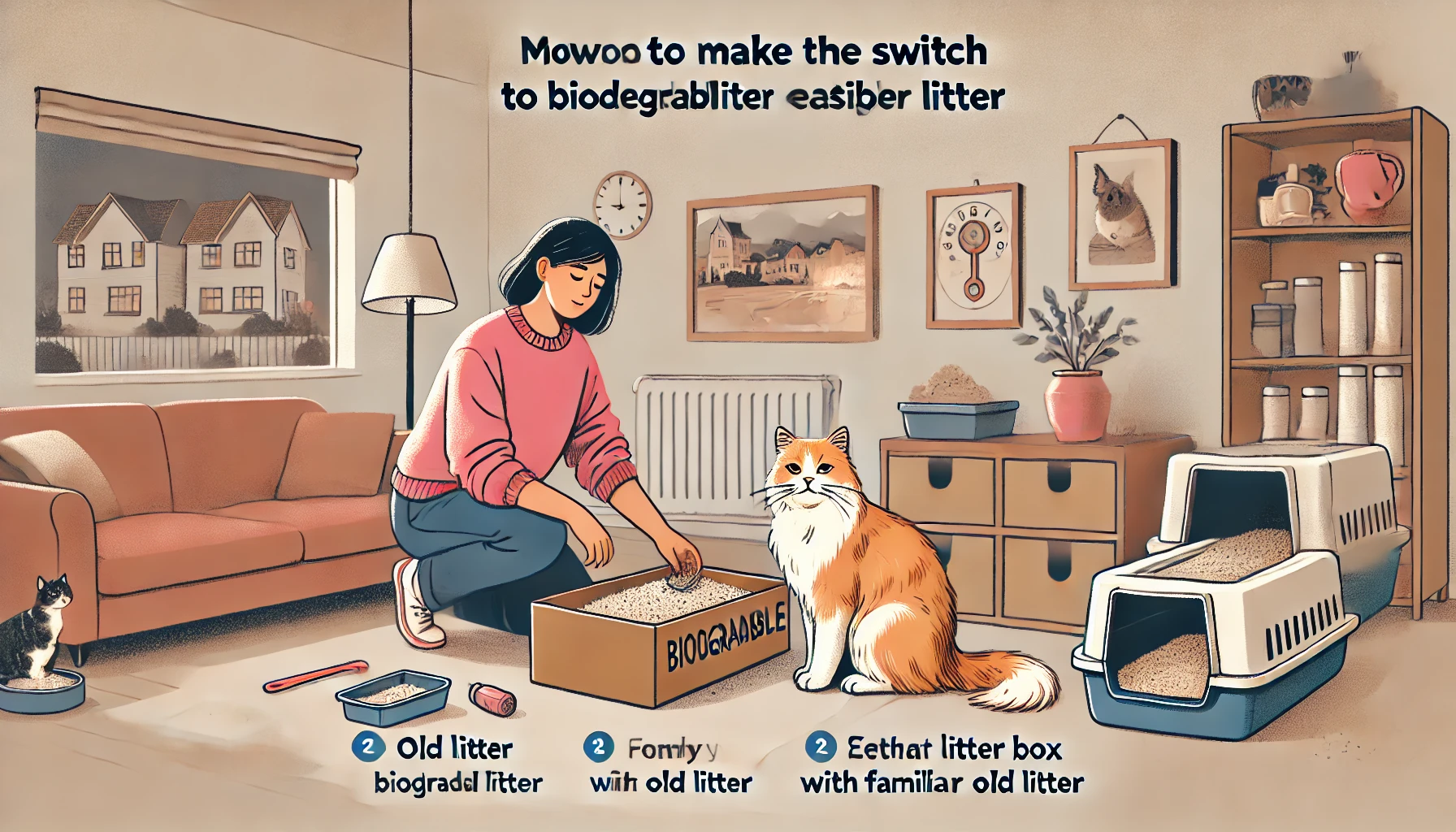
Making the Switch Easier for Your Cat
You can switch your cat to biodegradable cat litter with minimal hassle by introducing the change gradually.
Mixing the new litter with the old and observing your cat’s behavior will reduce stress and help your cat adjust comfortably.
Providing two litter boxes—one with the old litter and one with the new—gives your cat the freedom to choose, easing the transition.
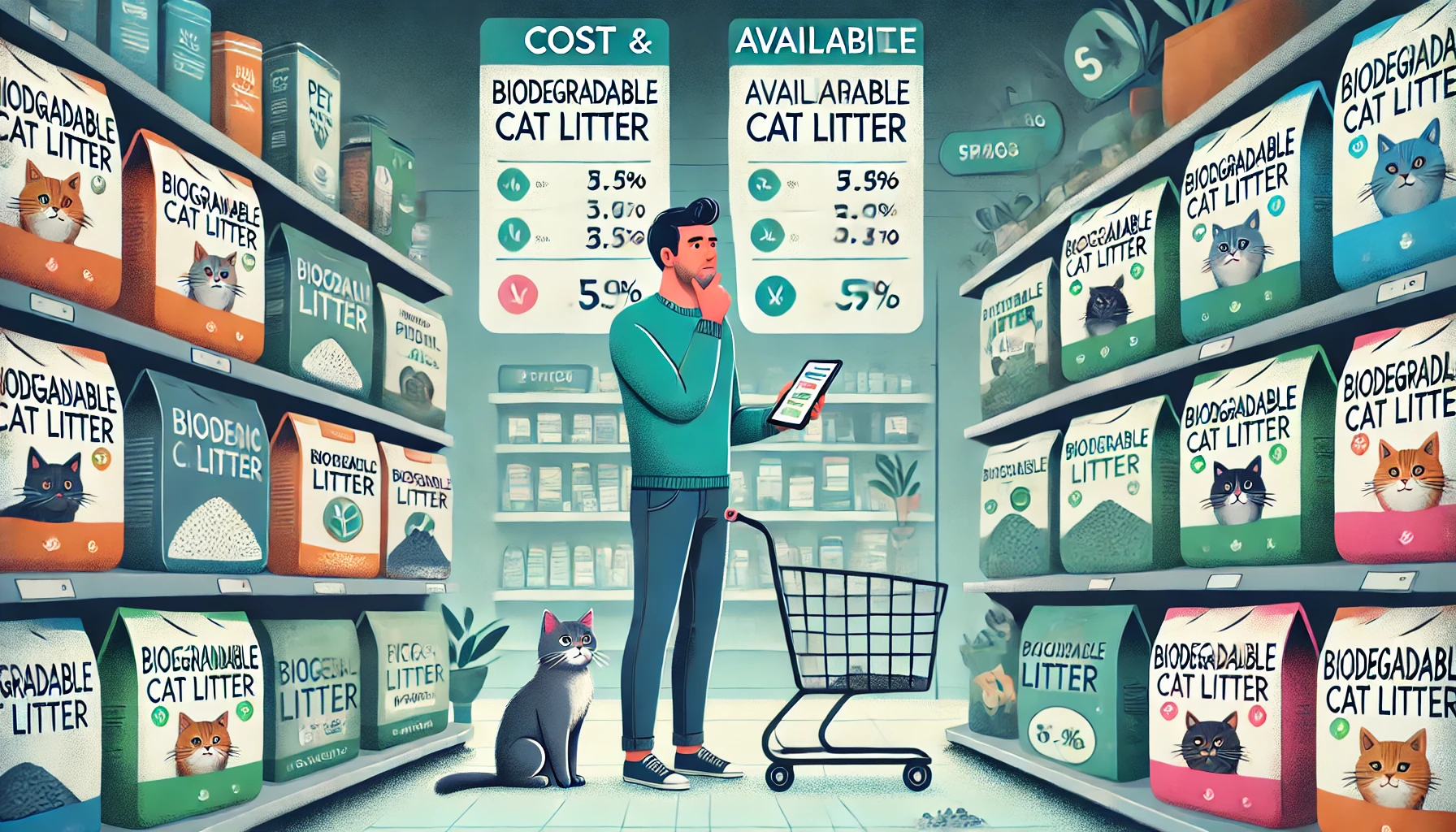
Cost and Availability Considerations
Although biodegradable cat litter may be slightly more expensive than traditional litters, its long-term advantages make it a worthwhile investment.
Many biodegradable litters are more absorbent, so you will use less over time, helping to offset the initial price difference.
With growing demand, biodegradable litter is now widely available at pet stores, supermarkets, and online retailers.
To save on costs, consider buying in bulk, looking for sales, and using subscription services.
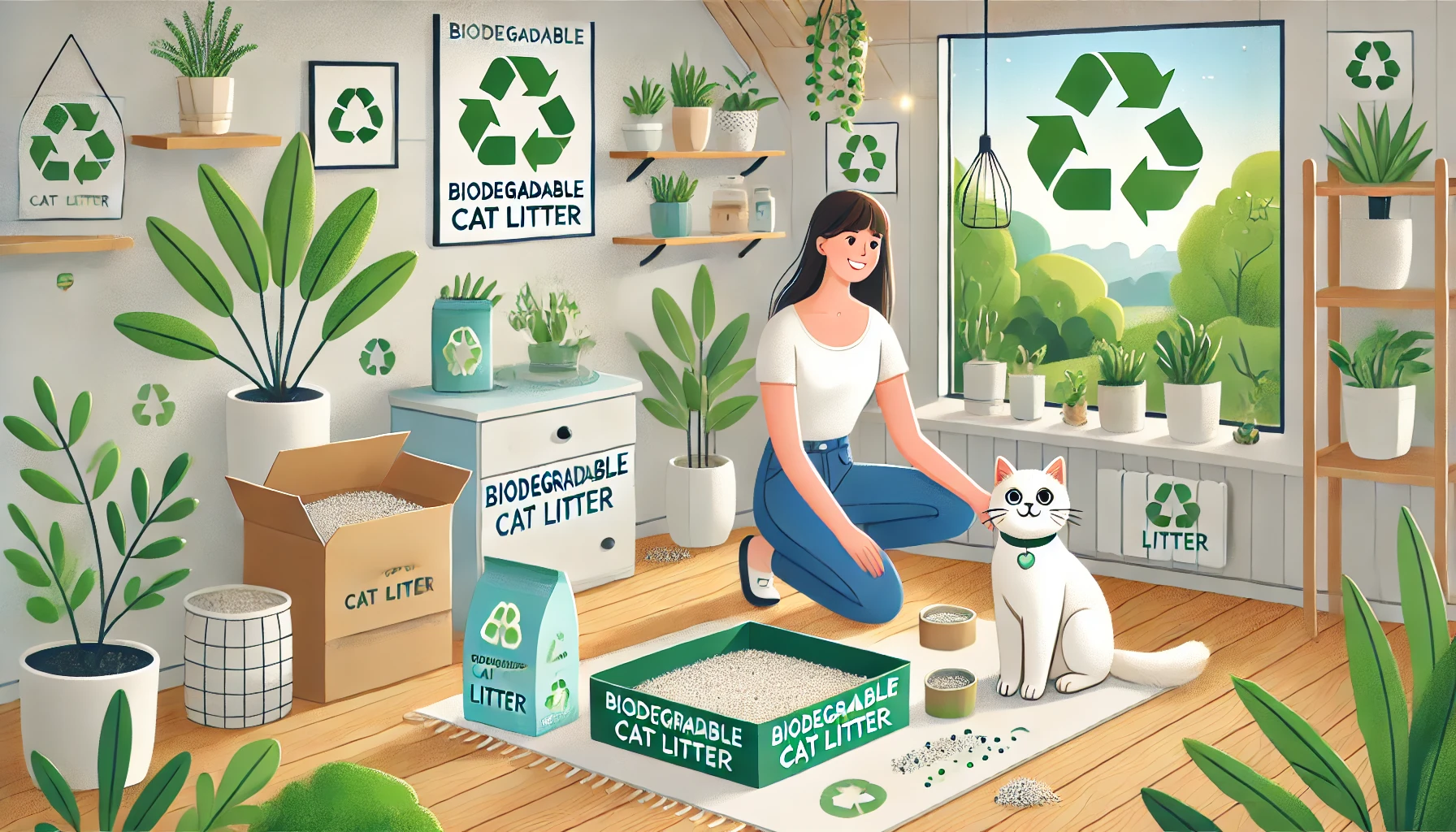
A Smarter Choice for You and the Environment
In conclusion, biodegradable cat litter not only has a positive environmental impact but is also a healthier choice for your cat and home.
Made from sustainable natural ingredients and reducing landfill waste, this litter offers a cleaner, safer, and more eco-friendly option for conscientious pet owners.
By making the switch, you contribute to a better future for your cat, your family, and the environment.
Switching to biodegradable litter benefits the environment, your cat’s health, and offers a sustainable option for conscientious pet owners.
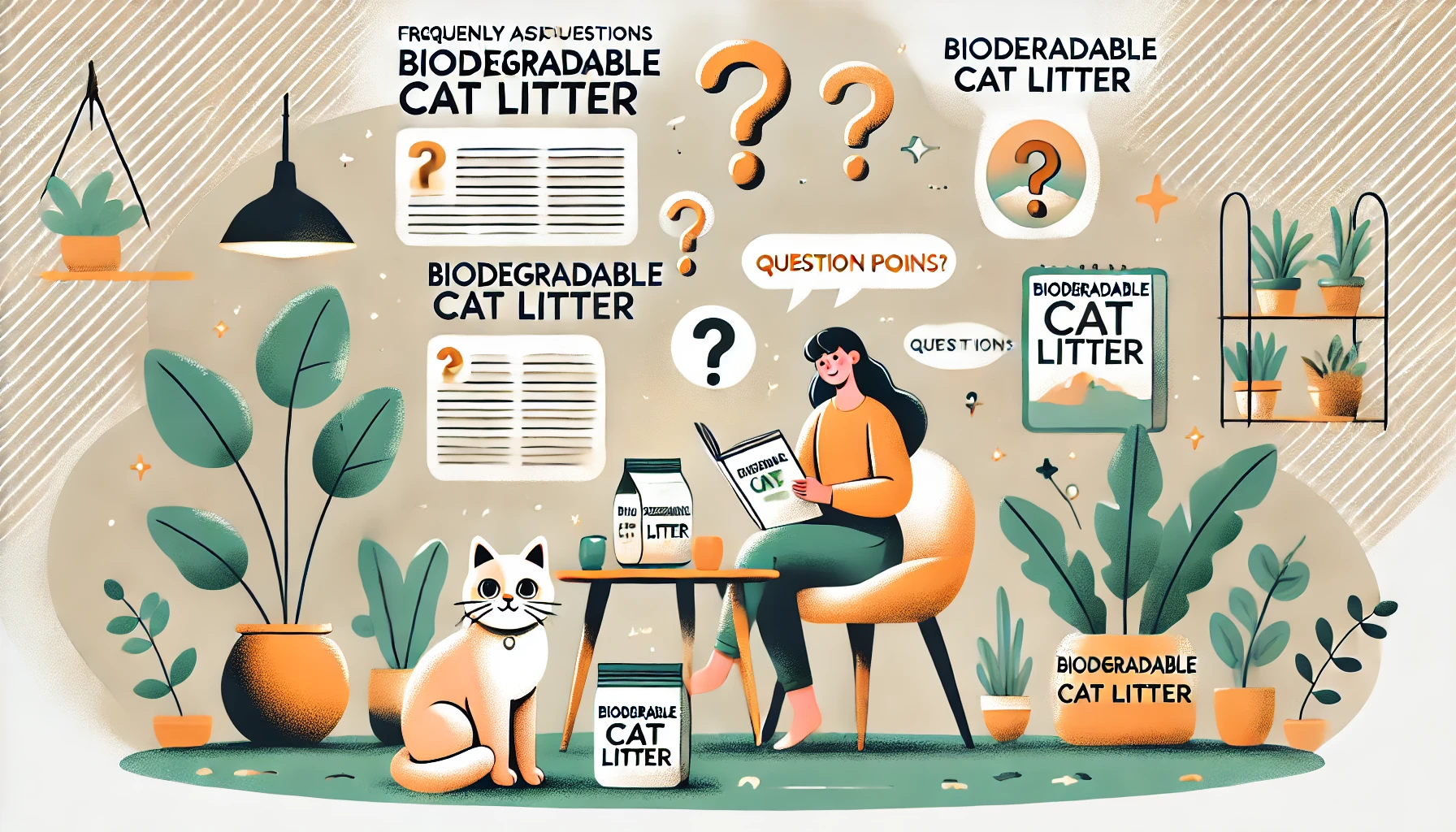
Frequently Asked Questions About Biodegradable Cat Litter
As more pet owners switch to biodegradable cat litter, common questions about its usage, benefits, and practical concerns arise.
Below are some of the most frequently asked questions on this topic, along with succinct answers.
What is biodegradable cat litter made of?
Biodegradable cat litter is made of natural materials such as wood, corn, wheat, paper, and other plant fibers.
These materials are renewable, decompose easily, and are an ecologically friendly choice compared to traditional clay-based litters.
Is biodegradable cat litter safe for my cat?
Yes, biodegradable cat litter is generally safe for cats.
It is made from natural, chemical-free materials and is mostly low in dust.
This makes it a much healthier option for your cat and your home environment.
Does biodegradable litter perform well in terms of odor control?
Yes, most biodegradable cat litters have good odor control, particularly wood or corn-based options.
These materials naturally absorb moisture and neutralize odors without the need for artificial fragrances or chemicals.
How often should I change biodegradable litter?
The frequency of changing biodegradable cat litter depends on the type and the number of cats using it.
Generally, clumping biodegradable litters should be scooped daily, and the entire box should be changed every two to four weeks.
Can biodegradable litter be composted?
Yes, most types of biodegradable cat litter are compostable.
However, it is essential to check if the litter is compostable, and never compost litter containing cat waste in food gardens to avoid contamination.
Is biodegradable cat litter more expensive than traditional litter?
Biodegradable cat litter is slightly more expensive than traditional litter.
However, the benefits of better absorption, low dust, and environmental concerns often outweigh the cost.
Savings can also be achieved by buying in bulk or during sales.
Does biodegradable litter last longer than clay litter?
Yes, biodegradable cat litter, especially clumping varieties, lasts longer than clay litter due to its absorbency.
Over time, you will use less biodegradable litter, which offsets the initial cost difference.
Can biodegradable cat litter be flushed down the toilet?
Biodegradable cat litter should not be flushed unless the packaging specifically states that it is safe to do so.
Flushing cat litter, even biodegradable types, can cause plumbing issues and harm water systems.
Will my cat adapt easily to biodegradable litter?
Most cats will adapt to biodegradable cat litter with a gradual introduction.
Mixing the new litter with the old over time or using two litter boxes will make the transition smoother and less stressful for your cat.

